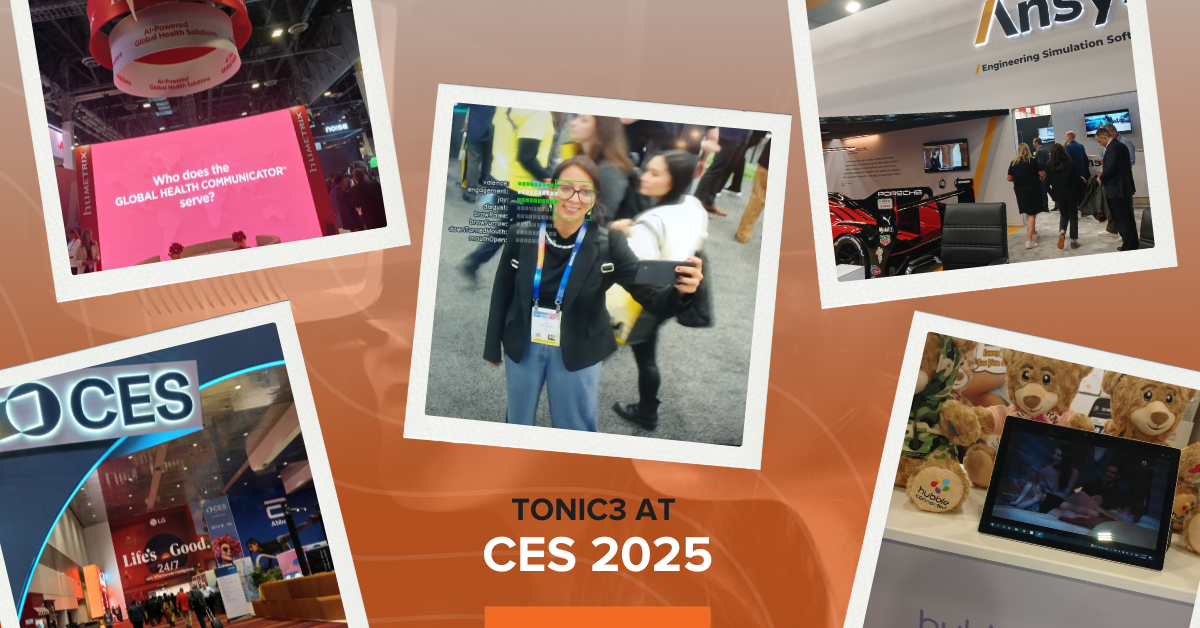Brands we saw at CES 2025 making tech awesome for humans

This mission was front and center at CES 2025, where we saw a number of brands showcasing technology that truly makes a difference in people's lives.
Open a new window to listen to this article.
We are shining a spotlight on some impressive brands who are making tech, especially AI, awesome for humans. These companies aren't just building cool gadgets to show off at the largest consumerelectronics show in the world; it’s evident they're creating tech that has been built with the end-user in mind. Developing a deep understanding of the customer problem is at the core of user-centric design and development.
These use cases should provide inspiration to teams building AI-powered products or internal systems, because good UX practices can be adapted to any development cycle. If your team isn’t sure how, that is something the digital architects at Tonic3 would be happy to discuss.
Sign-Speak
Uses AI for automated sign language recognition and avatars, working to enhance interaction between deaf, hard-of-hearing, and hearing individuals, with a focus on business interactions.
Nico Kelly introduced Sign-Speak as part of a panel we attended. Sign-Speak's approach to AI development in the sign language space reveals a strong commitment to user-centric design and ethical considerations. Their emphasis on building with, not just for, the Deaf community is evident in their community-centric approach. We enjoyed hearing about their focus on collaboration and iterative feedback loops to ensure the technology truly addresses the needs and preferences of its users. As an example, they are committed to using readily available 2D cameras, instead of specialized equipment, to ensure equity through accessibility and affordability. The team at Sign-Speak shows a thoughtful and inclusive philosophy, where AI is developed not just for technological advancement, but for genuine desire for the Deaf and Hard of Hearing community to benefit and thrive.
More about the AI-powered tech:
Niko explained the machine learning software is able to recognize sign language and translate it into the spoken word, thereby improving accessibility for the Deaf and Hard of Hearing community in the workplace and beyond. You can even join them in celebrating a big win! They received 2nd place at the CTA Pitch competition within the show.
DataEvolve.AI
The team behind DataEvolve.AI has a very specific user in mind – AI data engineers. This platform reduces the time spend on data engineering projects, giving it the potential to revolutionize the economics of data and analytics (D&A) projects by making them more productive, scalable, and affordable.
“Their cutting-edge solution has the potential to revolutionize the economics of data and analytics (D&A) projects for enterprise clients.” Brian Hodges, Account Exec with Tonic3.
More about the AI-powered tech:
This platform could drastically reduce the costs associated with hiring large data science teams—without sacrificing quality or speed. Imagine making D&A projects more productive, scalable, and affordable than ever before. This is the kind of innovation that can reshape industries and unlock new possibilities for enterprise customers.
ElliQ
We observed the demo of ElliQ offering a mix of practical reminders and emotional support for elderly patients. Sure, there are other well known voices in the “reminder” AI space, but the team behind ElliQ focused on creating an uplifting experience with a cheerful voice who plays music and tells jokes. And of course, we were happy to hear the product team refined the experience with a focus group representing the target user. You can get more details about the demo here, CES 2024: Older seniors are happily living with AI—in the form of chatty robot ElliQ.
“At Tonic3, we know that user experience is the bridge between innovation and adoption.” Brian Hodges, Account Executive with Tonic3
ElliQ was just one of several examples of human-centric AI in the Healthcare space. Read more about CES insights from attending a panel with leaders from Hippocratic AI, Curi Health, Figure 8, and Asha AI shared how generative AI is transforming patient care.
More about the AI-powered tech:
What we noted that was more customized to the use case is the purpose of asking the patient questions about how they are feeling to record that data to share with the care team. We could see where the visualized data for doctors is a game changer, creating a 360 degree view of the a patient’s health status.
Smart Eye AIS+
We will have no need for a mood ring when we are driving thanks to Smart Eye AIS. To improve driver safety, this AI-powered concept is studying facial expressions of drivers in real time to detect their mood and offer prompts to increase focus or advise the driver of potential safety risks.
Smart Eye's new AIS+ system, launched at CES 2025, showcases some interesting considerations for user experience in AI development. First, it's noteworthy that they've incorporated haptic alerts alongside visual and auditory ones. This suggests an understanding that different users respond to different stimuli, and offering a range of options allows for personalized feedback. Furthermore, the optional video recording functionality demonstrates a clear focus on user privacy. By giving users control over data collection, Smart Eye builds trust and addresses potential concerns about surveillance. Finally, and perhaps most importantly, the company explicitly states that AIS+ was developed in response to customer feedback. This emphasis on user research and iterative design is a key principle of good UX, and it's encouraging to see it applied in the development of AI-powered safety systems.
Does your company currently have AI product development projects in works?
You could benefit from our research findings. Answer these 6 questions to support our research.
More about the AI-powered tech:
Eye tracking uses a combination of cameras, infrared light and algorithms to learn the expressions of each face. Using multiple cameras, the program triangulates the face to better capture the unique differences and different angles for when drivers are moving and reacting to the environment around them. Learn about the power of eye-tracking technology and even download an ebook.
A simple mission: Don't forget the humans
Making tech, and AI, awesome for humans is our purpose! If you share in this mission, we'd love to connect.
The most successful products are those that seamlessly blend human-centered design with the power of AI. But don't just take our word for it, industry leaders from healthcare, finance, automation and tech all had a lot to say about the importance of remembering, and designing for, the human.
You can get the run down of the hot topics at CES 2025 here. And you can get our CEO's thoughts on UX-driven AI here.




